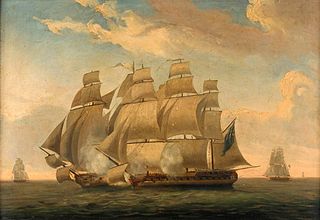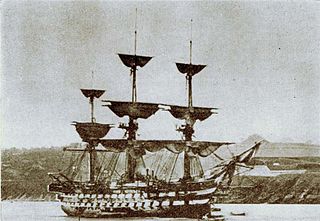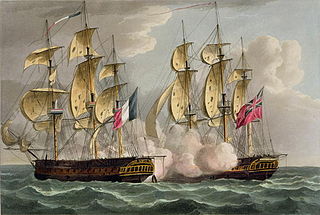
The Océan-class ships of the line were a series of 118-gun three-decker ships of the line of the French Navy, designed by engineer Jacques-Noël Sané. Fifteen were completed from 1788 on, with the last one entering service in 1854; a sixteenth was never completed, and four more were never laid down.

The Minerva-class sailing frigates were a series of four ships built to a 1778 design by Sir Edward Hunt, which served in the Royal Navy during the latter decades of the eighteenth century.

The Téméraire-class ships of the line were a class of a hundred and twenty 74-gun ships of the line ordered between 1782 and 1813 for the French navy or its attached navies in dependent (French-occupied) territories. Although a few of these were cancelled, the type was and remains the most numerous class of capital ship ever built to a single design.

The Sibylle class was a class of five 32-gun sail frigates designed by Jacques-Noël Sané and built for the French Navy in the late 1770s. They carried 26 x 12-pounder guns on the upper deck and 6 x 8-pounder guns on the forecastle and quarter deck.

The Pallas class constituted the standard design of 40-gun frigates of the French Navy during the Napoleonic Empire period. Jacques-Noël Sané designed them in 1805, as a development of his seven-ship Hortense class of 1802, and over the next eight years the Napoléonic government ordered in total 62 frigates to be built to this new design. Of these some 54 were completed, although ten of them were begun for the French Navy in shipyards within the French-occupied Netherlands or Italy, which were then under French occupation; these latter ships were completed for the Netherlands or Austrian navies after 1813.

The Romaine class was a class of nine frigates of the French Navy, designed in 1794 by Pierre-Alexandre Forfait. They were originally designated as "bomb-frigates" and were intended to carry a main armament of twenty 24-pounder guns and a 12-inch mortar mounted on a turntable in front of the mizzen mast. Experience quickly led to the mortars being removed, and the 24-pounders were replaced by 18-pounder guns. The ships also featured a shot furnace, but they proved impractical, dangerous to the ships themselves, and were later discarded. A further eleven ships ordered to this design in 1794 were not built, or were completed to altered designs.

The Roebuck-class ship was a class of twenty 44-gun sailing two-decker warships of the Royal Navy. The class carried two complete decks of guns, a lower battery of 18-pounders and an upper battery of 9-pounders. This battery enabled the vessel to deliver a broadside of 285 pounds. Most were constructed for service during the American Revolutionary War but continued to serve thereafter. By 1793 five were still on the active list. Ten were hospital ships, troopships or storeships. As troopships or storeships they had the guns on their lower deck removed. Many of the vessels in the class survived to take part in the Napoleonic Wars. In all, maritime incidents claimed five ships in the class and war claimed three.
The Adventure-class ship was a class of eight 44-gun sailing two-decker warships of the Royal Navy, classed as a fifth rate like a frigate, but carrying two complete decks of guns, a lower battery of 18-pounders and an upper battery of 12-pounders. This enabled the vessel to deliver a broadside of 318 pounds.

The Suffren class was a late type of 90-gun ships of the line of the French Navy.

The Nymphe class was a class of six 40-gun frigates of the French Navy, designed in 1781 by Pierre-Augustin Lamothe. The prototype (Nymphe) was one of the earliest 18 pounders (8.2 kg) armed frigates.

The Forte class was a class of two large frigates of the French Navy, designed in 1794 by François Caro. They carried 30 24-pounder long guns as their main battery and 20 x 8 pdrs on the quarterdeck and forecastle; they were exceptionally large and powerful heavy frigates for their time.

The Surveillante class was a type of sixty-gun frigate of the French Navy, designed in 1823 by Mathurin-François Boucher.

The Dryade Class was a type of 60-gun frigate of the French Navy, designed in 1823 by Paul-Marie Leroux.

The Concorde class was a type of 32-gun frigate of the French Navy, designed by Henri Chevillard, carrying 12-pounder long guns as their main armament. Three ships of this type were built between 1778 and 1779, and served during the American War of Independence and the French Revolutionary Wars.
The Minerve class was a type of 40-gun frigate of the French Navy, carrying 18-pounder long guns as their main armament. Six ships of this type were built at Toulon Dockyard, and launched between 1782 and 1794. The frigates served the French Navy briefly during the French Revolutionary Wars. The Royal Navy captured all six between 1793 and 1799 and took them into service, with all but one serving in the Napoleonic Wars, and some thereafter.

The Vengeance class was a type of large sailing frigates designed by Pierre Degay and built in Paimbœuf for the French Navy. Rated at 48 guns, the type was one of the French attempts at increasing the firepower of frigates by mounting a 24-pounder main battery, as was tried with Forfait's Romaine class. The attempt was unsuccessful, and the ships mounted 18-pounder long guns on their main gun deck while in service.
The Pourvoyeuse class was a type of heavy frigates of the French Navy, designed in the 1770s by Louis Boux. The class comprise two units, Pourvoyeuse and Consolante, which served in the Indian Ocean and were involved in the naval operations of the American Revolutionary War, notably serving in the squadron of Admiral de Suffren.

The Abeille class was a type of 16-gun brig-corvette of the French Navy, designed by François Pestel with some units refined by Pierre-Jacques-Nicolas Rolland. They were armed with either 24-pounder carronades, or a mixture of light 6-pounder long guns and lighter carronades. Twenty-one ships of this type were built between 1801 and 1812, and served in the Napoleonic Wars.

The Charmante class was a group of five 32-gun/12-pounder frigates of the French Navy, built during the late 1770s at Brest Nantes and Saint Malo. They were designed by Jean-Denis Chevillard. Of the five ships, two were wrecked, two were captured by the British, and one by the Spanish.















